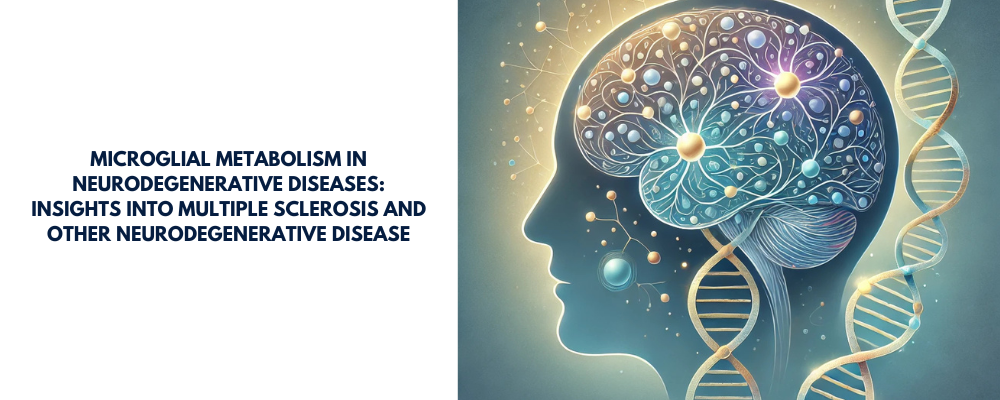Microglial Metabolism in Neurodegenerative Diseases: Insights into Multiple Sclerosis and Other Neurodegenerative Disease

Microglia, the immune sentinels of the central nervous system (CNS), play a dual role in maintaining brain homeostasis and driving neuroinflammation under pathological conditions. Recent advances reveal that metabolic reprogramming of microglia profoundly impacts neurodegenerative disorders, such as Alzheimer's disease (AD), Parkinson's disease (PD), Huntington's disease (HD), Multiple Sclerosis (MS), and Amyotrophic Lateral Sclerosis (ALS). This blog post delves into the metabolic adaptations of microglia and their implications in these diseases, based on the comprehensive review by Sadeghdoust et al. (2024) in Journal of Neuroinflammation.
Microglial Functions and Metabolic Shifts
Microglia serve as CNS guardians, detecting pathogens and promoting tissue repair. In a homeostatic state, their energy demands are met via oxidative phosphorylation (OXPHOS). However, during activation, microglia undergo metabolic reprogramming, shifting toward glycolysis—a phenomenon associated with enhanced proinflammatory responses. This metabolic plasticity enables microglia to adapt to CNS insults but may exacerbate neurodegeneration when dysregulated.
Key Metabolic Pathways in Neurodegeneration
Glycolysis and Aerobic Glycolysis
Inflammation triggers glycolytic activation in microglia. For instance, in AD, glycolysis promotes amyloid-β clearance initially but later drives inflammation through a feedback loop involving histone lactylation and pyruvate kinase M2 (PKM2) activation. Similarly, in MS, glycolysis supports demyelination, and in PD, α-synuclein exposure induces aerobic glycolysis, amplifying proinflammatory cascades.
Lipid Metabolism
Lipids serve as an energy source for activated microglia. In AD, lipid accumulation due to TREM2-ApoE signaling disrupts homeostasis, while in MS, cholesterol metabolites exacerbate inflammation. Contrastingly, omega-3 fatty acids promote anti-inflammatory phenotypes, offering therapeutic potential.
Amino Acid Metabolism
Amino acids such as glutamine and tryptophan modulate microglial phenotypes. For example, in MS, the aromatic amino acid oxidase IL4I1 facilitates remyelination, while disruptions in tryptophan metabolism in HD lead to neurotoxic quinolinic acid production.
Iron Metabolism
Iron-laden microglia are a hallmark of AD and MS, where excess iron induces oxidative stress and amplifies inflammation. Targeting iron metabolism may mitigate these effects.
Disease-Specific Insights
Alzheimer's Disease: Altered glucose metabolism and lipid dysregulation in microglia contribute to amyloid-β plaque persistence and neurofibrillary tangle formation.
Multiple Sclerosis: Metabolic flexibility of microglia facilitates inflammation in demyelinating lesions, with iron and lipid metabolism playing critical roles in disease progression.
Parkinson’s Disease: α-synuclein disrupts glucose and amino acid metabolism in microglia, exacerbating neuronal loss.
Huntington’s Disease: Mutant huntingtin protein triggers microglial activation through the kynurenine pathway, leading to chronic inflammation.
Amyotrophic Lateral Sclerosis: Mitochondrial dysfunction and impaired glucose metabolism in microglia are linked to motor neuron degeneration.
Microglial Metabolism in MS
Microglia are central to both the immune response and repair mechanisms in the CNS. During MS, these cells transition between states of proinflammation and repair, modulated by metabolic cues. This flexibility allows microglia to respond to CNS damage but also contributes to the pathology when dysregulated.
Key metabolic pathways influencing microglial function in MS include:
Glycolysis and Aerobic Glycolysis
In MS lesions, microglia exhibit elevated glycolytic activity, driven by glucose transporters such as GLUT3. Glycolysis supports the inflammatory response, fueling the production of proinflammatory cytokines like interleukin-1β (IL-1β). This pathway, however, becomes a double-edged sword—while it helps clear myelin debris, prolonged activation exacerbates inflammation and neurodegeneration. Interestingly, studies in experimental autoimmune encephalomyelitis (EAE), a mouse model of MS, show that targeting glycolysis through lactate export inhibition dampens inflammation and reduces disease severity.
Lipid Metabolism
The demyelination process releases large amounts of myelin, rich in lipids. Microglia metabolize these lipids to sustain their heightened energy demands during activation. However, cholesterol oxidation products like 7-keto-cholesterol (7KC) can induce oxidative stress and inflammatory responses. Conversely, dietary interventions, such as omega-3 fatty acids and ketogenic diets, have shown promise in suppressing microglial activation and promoting anti-inflammatory phenotypes in MS.
Iron Metabolism
Iron accumulation in microglia at the rims of chronic active lesions is a hallmark of progressive MS. This excess iron triggers oxidative stress and inflammatory signaling, further damaging neurons. Advanced imaging techniques now allow researchers to link iron overload with specific inflammatory microglial phenotypes, offering potential targets for therapeutic interventions.
Amino Acid Metabolism
Amino acids such as glutamine and tryptophan are pivotal in microglial activation and repair. For example, glutamine supports ATP production via the TCA cycle but also promotes inflammatory IL-1β production under pathological conditions. Aromatic amino acid metabolites in cerebrospinal fluid are strongly associated with MS disability, suggesting their potential as biomarkers.
Therapeutic Implications
Emerging research underscores the therapeutic potential of modulating microglial metabolism:
Glycolysis Inhibition: Targeting glycolytic enzymes such as hexokinase 1 or pyruvate dehydrogenase kinase can attenuate inflammation.
Lipid Metabolism Enhancement: Omega-3 fatty acids and ketogenic diets show promise in reprogramming microglia toward neuroprotection.
Iron Homeostasis: Strategies to limit iron accumulation in microglia may alleviate oxidative stress in neurodegenerative diseases.
Challenges and Future Directions
While metabolic targeting holds promise, the heterogeneity of microglia poses challenges for therapeutic development. Microglial phenotypes vary across diseases, brain regions, and activation states, necessitating tailored interventions. Moreover, off-target effects and compensatory metabolic shifts warrant further investigation to ensure efficacy and safety.
Conclusion
Microglial metabolism is a cornerstone of CNS health and disease. By unraveling the metabolic underpinnings of microglial functions, we can identify novel therapeutic avenues for treating neurodegenerative disorders. Continued research in this domain offers hope for mitigating the burden of these debilitating conditions.
Reference:
Sadeghdoust, M., Das, A., & Kaushik, D. K. (2024). Fueling neurodegeneration: metabolic insights into microglia functions. Journal of neuroinflammation, 21(1), 300. https://doi.org/10.1186/s12974-024-03296-0
